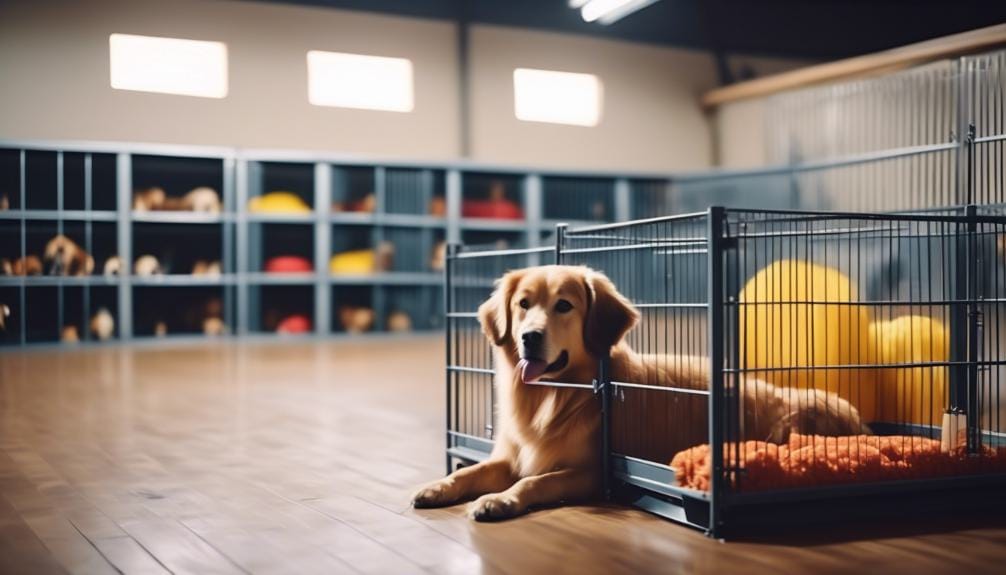You know the saying, ‘Absence makes the heart grow fonder,’ but when it comes to boarding your dog, how long is too long?
Understanding the important factors that come into play when boarding your furry friend can make all the difference in their well-being.
From the ideal duration for boarding to potential risks and tips for a smooth boarding experience, there’s a lot to consider.
So, before you make any decisions, let’s explore the crucial things you need to know to ensure your dog’s comfort and happiness while in boarding care.
Key Takeaways
- Most dogs can handle being in a boarding facility for 2 to 4 weeks.
- Some dogs may show signs of distress after just a few days, especially if they have separation anxiety or anti-social behavior.
- Mixing boarding with pet sitting can provide variety and breaks in routine.
- Leaving your dog for more than 4 weeks is generally considered too long.
Appropriate Duration for Dog Boarding
If you’re considering boarding your dog, it’s important to understand the appropriate duration for their stay to ensure their well-being and comfort.
Most dogs can handle being in a boarding facility for two to four weeks, but it’s crucial to gauge your dog’s reaction. Some dogs may show signs of distress after just a few days, especially if they’ve separation anxiety or anti-social behavior.
It’s essential to communicate with the boarding staff and understand their limits on boarding duration, as some kennels may have their own policies in place. Leaving your dog behind for anything beyond four weeks is generally considered too long for dog boarding.
To provide variety and breaks in routine, consider mixing boarding with pet sitting. This allows your dog to spend some time at home, which can be beneficial.
Always ensure that the boarding facility provides excellent boarding services and has a caring and attentive staff to look after your beloved pet during their time away from home.
Factors Affecting Boarding Duration

Considering the appropriate duration for your dog’s boarding stay is crucial, and now we will explore the various factors that can affect this decision. Boarding facilities list answers to these factors, helping you determine if your dog is eligible for boarding services and how long you can board your dog. The boarding facility offered, the dog’s medical needs, and their temperament all play a role in the duration your dog can be boarded. If your dog has serious medical conditions or diseases that require monitoring, vet nurses will offer the necessary care, but this may limit how long your dog can tolerate being boarded. Additionally, if your dog has separation anxiety or anti-social behavior, the boarding duration may need to be limited. On the other hand, providing a comfortable and familiar environment can help your dog enjoy their stay, potentially allowing you to board your dog longer. It’s important to note that boarding a dog is a personal decision, and finding a balance that helps lessen your guilt and ensures your dog’s well-being is key.
| Factors Affecting Boarding Duration | Impact |
|---|---|
| Dog’s temperament | May limit duration |
| Medical needs | Limits boarding duration |
| Mixing options | Can impact duration |
| Kennel policies | Sets boarding limits |
Potential Risks of Extended Boarding

Extended boarding can pose several risks for your dog, including heightened stress levels and increased susceptibility to illness from close proximity with other dogs. When considering a long stay for your pet at a boarding facility, it’s crucial to be aware of the potential risks involved.
Here’s what you need to know:
- Medical Issues: Dogs in close quarters at boarding facilities are at a higher risk of contracting illnesses from other dogs, especially if they aren’t up to date on vaccinations. This can lead to your pet requiring medical attention from a veterinarian.
- Behavioral Challenges: Adjusting to a new environment can be stressful for some dogs, potentially leading to behavioral issues such as anxiety, depression, or increased aggression. These challenges may persist even after returning home from the boarding facility.
- Injury and Accidents: Unfamiliar surroundings can increase the likelihood of injuries or accidents, especially if the facility isn’t properly maintained or if the dog isn’t closely monitored.
It’s important to carefully assess the boarding facility and take necessary precautions to minimize these risks for your furry friend.
Tips for a Smooth Boarding Experience

When preparing your dog for a smooth boarding experience, it’s essential to take proactive steps to minimize potential risks and ensure their comfort and well-being.
- Visiting the boarding facility beforehand allows your dog to become familiar with the environment and the staff. Consistency in boarding facilities can also help your dog feel more at ease, reducing stress.
- Additionally, consider grooming services to freshen up your dog before pick-up, enhancing their comfort after boarding. Choose a facility that offers live feeds of doggy play areas for peace of mind and to check on your pet.
- Sending familiar items, such as their bed and a blanket from home, can also help your dog feel more comfortable during a prolonged stay. Moreover, it’s crucial to leave detailed care instructions and emergency contact information with the boarding facility. Consider providing the facility with your veterinarian’s contact information in case of any medical issues.
- Finally, if your dog has specific medical needs, consider providing a pet CPR and first aid kit, or discuss these needs with the facility to ensure proper care.
Preparing Your Dog for Boarding

To prepare your dog for boarding, it’s important to acquaint them with the facility and pack essential items for their comfort and well-being.
First, take your dog for a visit to the boarding kennel. This will help familiarize them with the environment and reduce anxiety during their stay.
Next, pack essential items such as your dog’s food, medications, favorite toys, and bedding to provide a sense of familiarity. Additionally, provide clear instructions on your dog’s feeding schedule, exercise routine, and any special needs they may have. This will help ensure that your dog’s routine is maintained as closely as possible.
Lastly, leave emergency contact information for yourself and a backup person, as well as any pertinent medical information.
Frequently Asked Questions
What Is the Longest Time You Should Board a Dog?
You should board a dog for a maximum of four weeks. Beyond that, it’s considered too long. Keep in mind that individual kennels may have their own limits. Dogs with separation anxiety may need alternative options like pet sitters.
How Long Is Too Long in a Kennel?
Staying in a kennel for extended periods can be stressful for most dogs. It’s important to consider your dog’s needs and behavior. Some may handle longer stays, but it’s crucial to watch for signs of distress.
Do Dogs Know How Long They Are Boarded?
Dogs don’t have a sense of time like humans do, but they can feel the duration of being boarded. They rely on routine and familiar surroundings. Regular visits and a comfortable environment can help them feel secure.
How Long Can You Safely Leave a Dog in a Kennel?
You can safely leave a dog in a kennel for two to four weeks, but some dogs may react negatively after two weeks. Consider alternatives for dogs with separation anxiety. Mixing boarding options can help alleviate stress.
Conclusion
In conclusion, when considering boarding your dog, it’s important to be mindful of the duration of the stay and factors that can impact their experience.
Most dogs can handle two to four weeks of boarding, but some may show signs of distress after two weeks.
It’s crucial to choose a boarding facility that meets certain criteria and to consider alternatives like hiring a pet sitter.
By taking these factors into account, you can ensure a smooth and positive boarding experience for your furry friend.





Leave a Reply
You must be logged in to post a comment.